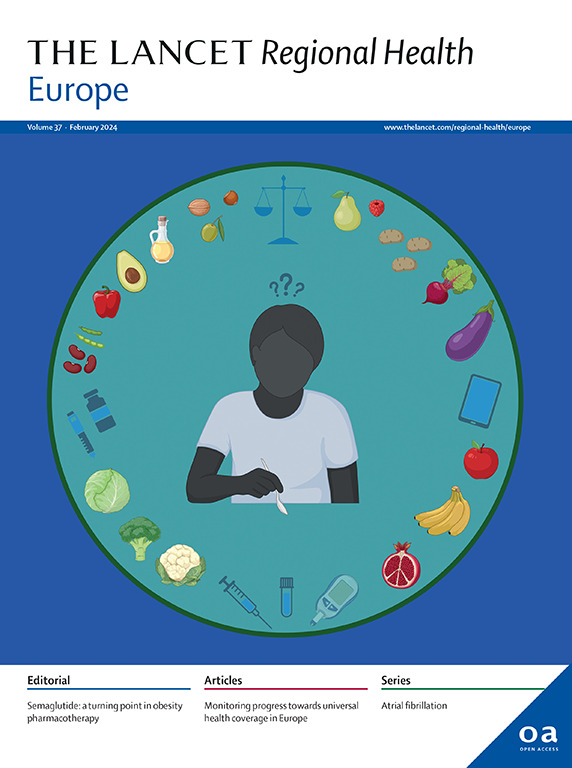乳腺癌高剂量辅助化疗获益:随机3期PANTHER试验亚组分析
IF 13.6
Q1 HEALTH CARE SCIENCES & SERVICES
引用次数: 0
摘要
背景:目前尚不清楚是否一些高风险乳腺癌患者由于预期绝对获益小而不需要辅助剂量密集化疗。方法:3期PANTHER试验(NCT00798070)比较了高危早期乳腺癌切除患者以定制剂量密度(tDD EC/D)或标准间隔计划(FEC/D)给药的序贯表柔比星/环磷酰胺(EC)和多西紫杉醇(D)的辅助治疗(n = 2003)。我们比较了关键亚组的结果,评估了在线预测和治疗获益估计工具PREDICT的性能,并进行了亚群治疗效果模式图(STEPP)分析。主要终点为乳腺癌无复发生存期(BCRFS)。结果:中位随访时间为10.3年。tDD EC/D治疗改善了所有亚组的10年BCRFS,包括根据绝经状态,绝对获益为2%或以上,以及luminal(风险比[HR] = 0.83, 95%可信区间[CI] 0.65-1.05)和人表皮生长因子受体2 (HER2)阳性(HR = 0.53, 95% CI 0.30-0.93),但三阴性乳腺癌患者(HR = 1.02, 95% CI 0.66-1.57)。PREDICT低估了整个人群和所有亚组的总生存率。在STEPP分析中,tDD EC/D对BCRFS患者的绝对获益在风险定义的亚群中是稳定的,从最低风险患者的3.8%到最高风险患者的3.6%。随着时间的推移,没有不同的治疗效果。解释:我们不能可靠地确定任何不受益于剂量密集治疗的亚组,对于原发性切除的高危乳腺癌患者应考虑剂量密集治疗。资助:Cancerfonden, Bröstcancerförbundet, Radiumhemmets Forskningsfonder,安进,罗氏,赛诺菲安万特。本文章由计算机程序翻译,如有差异,请以英文原文为准。
Benefit from dose-dense adjuvant chemotherapy for breast cancer: subgroup analyses from the randomised phase 3 PANTHER trial
Background
It is unclear whether some patients with high-risk breast cancer do not warrant adjuvant dose-dense chemotherapy due to small expected absolute benefit.
Methods
The phase 3 PANTHER trial (NCT00798070) compared adjuvant sequential epirubicin/cyclophosphamide (EC) and docetaxel (D) administered in either tailored dose-dense (tDD EC/D) or standard interval schedule (FEC/D) to patients with high-risk resected early breast cancer (n = 2003). We compared outcomes across key subgroups of interest, evaluated the performance of the online prognostication and treatment benefit estimation tool PREDICT and conducted a subpopulation treatment effect pattern plot (STEPP) analysis. Primary endpoint was breast cancer recurrence free survival (BCRFS).
Findings
Median follow-up was 10.3 years. Treatment with tDD EC/D improved 10-year BCRFS across all subgroups including according to menopausal status, with an absolute benefit of 2% or more, as well as in luminal (Hazard Ratio [HR] = 0.83, 95% Confidence Interval [CI] 0.65–1.05) and Human Epidermal Growth Factor Receptor 2 (HER2) positive (HR = 0.53, 95% CI 0.30–0.93), but not triple negative breast cancer patients (HR = 1.02, 95% CI 0.66–1.57). PREDICT underestimated overall survival in the entire population and across all subgroups. In STEPP analysis, absolute benefit from tDD EC/D in BCRFS was stable across risk-defined subpopulations, from 3.8% in the lowest risk patients to 3.6% in the highest risk ones. There was no differential treatment effect over time.
Interpretation
We could not reliably identify any subgroup not benefiting from dose-dense treatment, which should be considered for patients with primary resected high-risk breast cancer.
Funding
Cancerfonden, Bröstcancerförbundet, Radiumhemmets Forskningsfonder, Amgen, Roche, sanofi-aventis.
求助全文
通过发布文献求助,成功后即可免费获取论文全文。
去求助
来源期刊

Lancet Regional Health-Europe
Multiple-
CiteScore
19.90
自引率
1.40%
发文量
260
审稿时长
9 weeks
期刊介绍:
The Lancet Regional Health – Europe, a gold open access journal, is part of The Lancet's global effort to promote healthcare quality and accessibility worldwide. It focuses on advancing clinical practice and health policy in the European region to enhance health outcomes. The journal publishes high-quality original research advocating changes in clinical practice and health policy. It also includes reviews, commentaries, and opinion pieces on regional health topics, such as infection and disease prevention, healthy aging, and reducing health disparities.
 求助内容:
求助内容: 应助结果提醒方式:
应助结果提醒方式:


